Are you in search of an affordable yet top-quality keyboard or electric piano that doesn’t compromise on features?
Navigating the plethora of options available in the market can be overwhelming, particularly when brands offer similar features at comparable price points. The key is to strike the perfect balance that fits your budget while meeting your musical requirements.
Enter the arena of budget-friendly digital pianos, where two standout contenders, the Alesis Recital Pro, and the Yamaha P45, vie for attention.
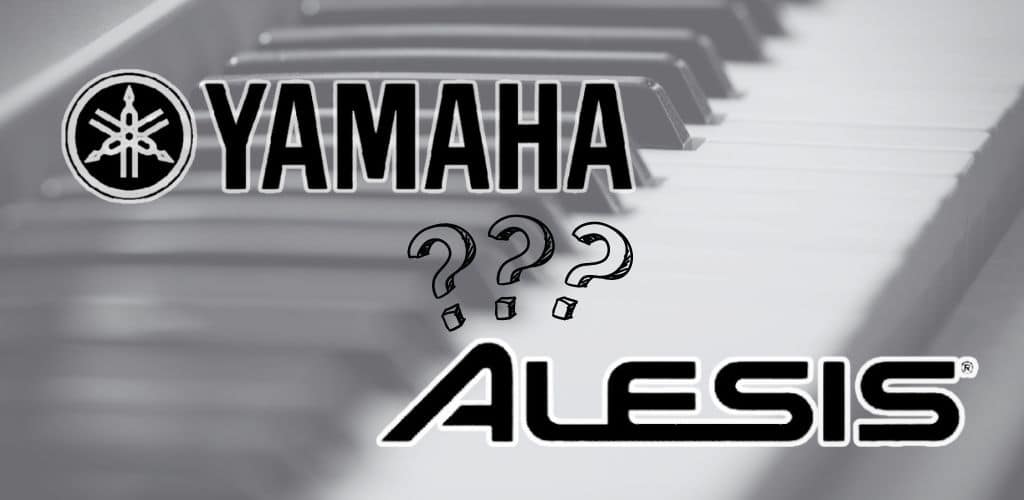
Renowned for providing an excellent entry point for beginners, these digital pianos offer a realistic and gratifying playing experience without skimping on design quality.
In this comprehensive guide, I embark on a detailed comparison of the Alesis Recital Pro Vs Yamaha P45, aiming to help you discern the ideal companion for your musical journey.
I’ve borrowed both instruments for three weeks from my local store, to really test them out ‘in the real world’.
The Alesis Recital Pro
Digital Piano
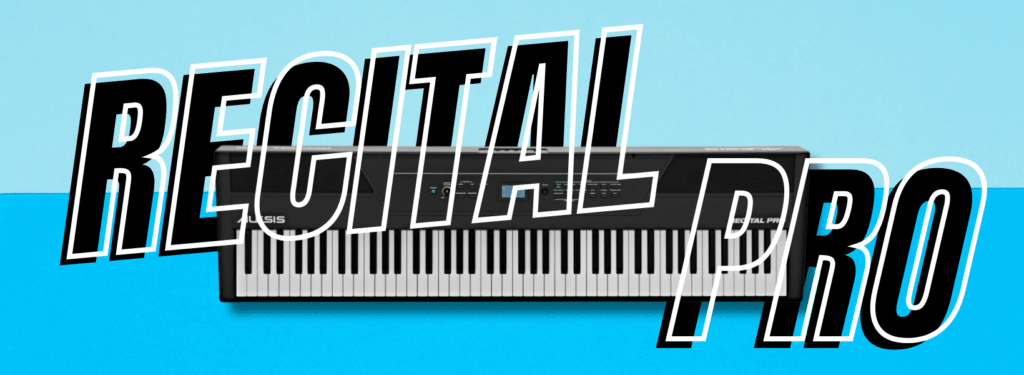
Introducing the Alesis Recital Pro Digital Piano – an exquisite harmony of innovation and performance tailored for musicians seeking a stellar playing experience.
As you embark on your musical journey, the Alesis Recital Pro stands out as a compelling choice, boasting cutting-edge features that strike a perfect balance between affordability and advanced functionality.
Dive into a world where precision meets passion, and let the Alesis Recital Pro redefine your expectations of a piano.
Alesis Recital Pro 88 Note Digital Piano
Experience the Alesis Recital Pro Digital Piano – 88 full-sized hammer-action keys deliver a realistic touch, with adjustable touch response for personalized playing.
Explore 12 premium voices, including acoustic piano, vibraphone, organ, and more, with the option to layer two voices for richer tones. Ideal for beginners, its lesson mode facilitates easy learning, while the built-in metronome keeps you in time.
Connect headphones for private practice or use stereo outputs for live performances. With USB-MIDI connectivity and 3 months of Skoove Premium included, enhance your skills and creativity.
Alesis Recital Pro 88 Note Digital Piano

FEATURES: 88 premium full-sized hammer-action keys
OTHER INFO: 12 built-in premium voices
- Realistic hammer-action keys for an authentic playing experience
- Wide range of built-in voices and effects for versatility
- Lesson mode and Skoove premium offer valuable learning resources
- Can be powered by batteries for on-the-go playing
- USB-MIDI output for connecting to computers and software
- Sustain pedal not included
When you click ‘Check Price’, you’ll see there are loads of great places to buy this item. Our personal favorite is Sweetwater for the US, and Thomann and Gear4Music for the UK & Europe.
They are the largest music retailers, with excellent customer service, competitive prices, really fast shipping, and the longest guarantees.
The professional musician who wrote this article combined many things,
from the product build, manufacturer’s reputation through to feedback
from other users, to create our famous TedScore™.
The Yamaha P45 Digital Piano
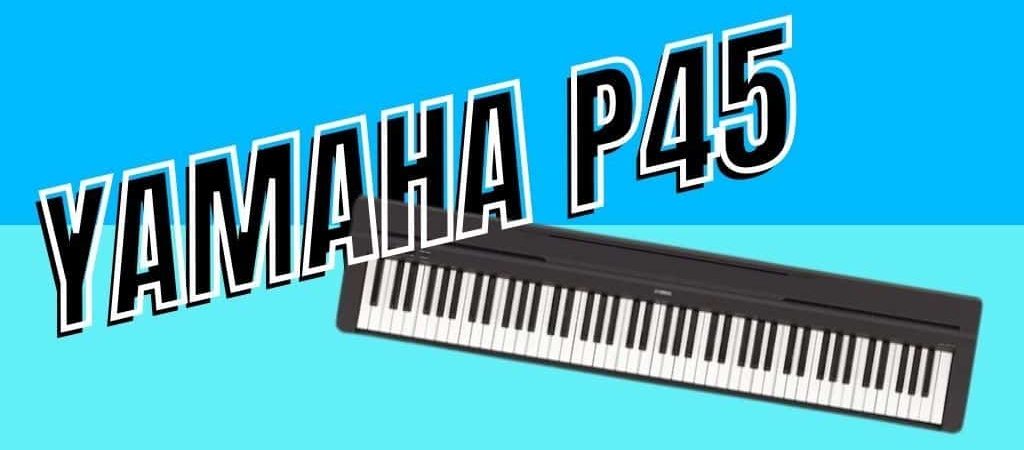
Let’s shift our spotlight to the Yamaha P45 Digital Piano – a masterpiece in its own right, offering a symphony of elegance and functionality. Yamaha has long been synonymous with musical excellence, and the P45 lives up to this legacy.
Designed with meticulous attention to detail, the Yamaha P seamlessly blends affordability with the unmistakable touch and tone that has made Yamaha a household name among musicians.
Prepare to be captivated by the P45’s prowess as we explore the nuances that set it apart in the world of digital pianos.
Yamaha P45 Digital Piano, Black
Yamaha P45: a digital piano that blends a true piano feel with performance-ready sound.
With its graded hammer standard keyboard, you’ll experience authentic resistance across all 88 keys, enhancing your playing technique.
Thanks to advanced wave memory technology, the P45 produces expressive tones with rich tone quality, rivaling acoustic pianos.
This portable piano weighs just 11.5kg and boasts a slim design, making it easy to transport to gigs and rehearsals without sacrificing authentic sound. Plus, with features like USB to Host connectivity and built-in amplifiers and speakers, you can start playing right away.
Explore all the voices available with the Grand Piano/Function button, and layer multiple voices to create your own unique sound.
Whether you’re a beginner or an experienced player, the Yamaha P45 offers a satisfying playing experience that inspires creativity and musical expression.
Yamaha P45 Digital Piano
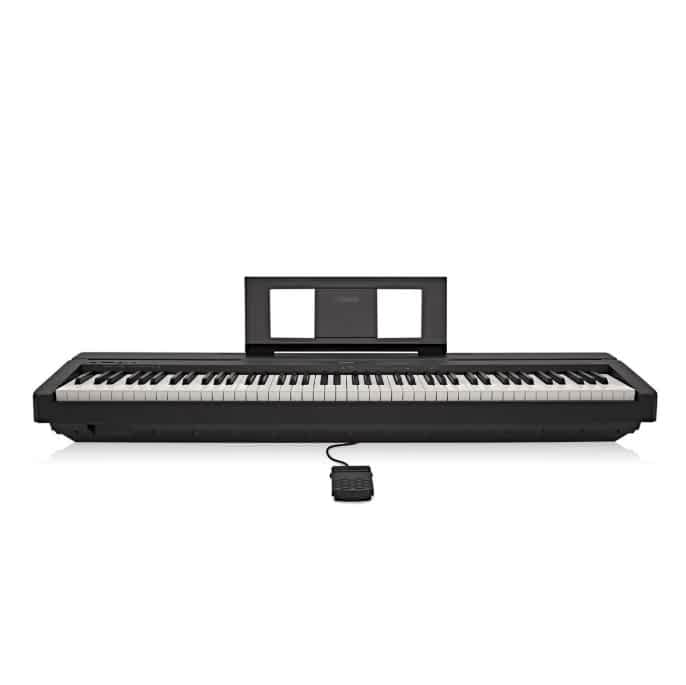
FEATURES: Graded Hammer Standard (GHS) keyboard
OTHER INFO:AMW Stereo Sampling
- Authentic piano feel with graded hammer standard keyboard
- Portable and lightweight design for easy transportation
- Versatile features including USB connectivity and layering capabilities
- Expressive and realistic tone quality thanks to advanced wave memory technology
- Three months of Flowkey Premium for interactive piano tutorials
- Does not come with a stand included
When you click ‘Check Price’, you’ll see there are loads of great places to buy this item. Our personal favorite is Sweetwater for the US, and Thomann and Gear4Music for the UK & Europe.
They are the largest music retailers, with excellent customer service, competitive prices, really fast shipping, and the longest guarantees.
The professional musician who wrote this article combined many things,
from the product build, manufacturer’s reputation through to feedback
from other users, to create our famous TedScore™.
Performance and Features Compared
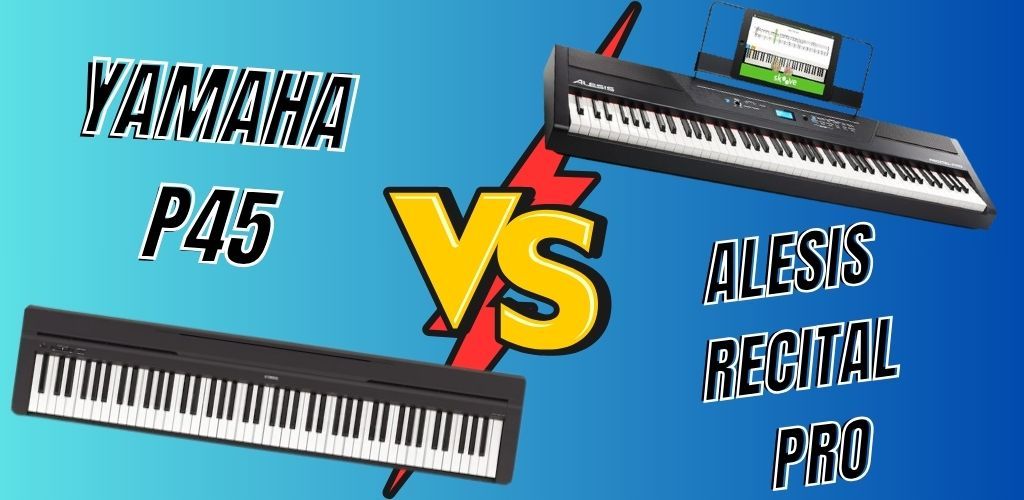
Both the Alesis Recital Pro and the P45 fall under the “under \$500” category, offering an impressive array of features at a relatively accessible price point.
However, delving deeper into their performance reveals nuanced differences that may sway your decision.
Keyboard Action and Sensitivity
Key action and sensitivity play a pivotal role in replicating the feel of an acoustic piano. The P45’s graded hammer action stands out, offering a nuanced touch that mimics the feel of a grand or upright piano.
This feature makes the Yamaha P a preferred choice for pianists seeking an authentic playing experience that closely resembles that of a traditional acoustic piano.
In contrast, the Alesis Recital Pro’s hammer action keys provide a commendable upgrade from semi-weighted keys, offering a more realistic feel compared to other keyboards in its price range.
While the keys on the Recital Pro lack the nuanced bounce back of the Yamaha P, they still provide a satisfactory playing experience for beginners and intermediate players alike.
Polyphony and Layering Capabilities
Polyphony, the ability to produce multiple sounds simultaneously, is crucial for playing complex melodies and layering sounds effectively.
The Alesis Recital Pro edges ahead with a 128-note polyphony compared to the P45’s 64 notes, offering enhanced versatility for budding musicians exploring more intricate compositions.
Additionally, both models feature layering capabilities, allowing you to combine two sounds for rich, textured performances.
This feature is particularly useful for creating dynamic and expressive music compositions, making both the Alesis Recital Pro and the P45 suitable options for musicians of varying skill levels.
Built-in Sounds and Voices
The quality and variety of built-in sounds are paramount for crafting your musical repertoire. While the Alesis Recital Pro boasts 12 distinct sounds, including strings and electric voices, the P45 offers a slightly smaller selection of 10 voices.
However, the Yamaha’s sound engine, sampled from their renowned pianos, delivers superior realism and depth, making it a standout choice for purists seeking an authentic piano-playing experience.
The P45’s sound quality is further enhanced by its Advanced Wave Memory Stereo Sampling technology, which faithfully reproduces the nuances of acoustic piano tones with remarkable clarity and precision.
On the other hand, while the Alesis Recital Pro offers a wider range of sounds, including various instrument voices and effects, the quality may vary across different sounds.
Some voices may sound more realistic and high-quality, while others may exhibit a more generic or synthetic tone.
Nonetheless, the Alesis Recital Pro provides ample versatility for experimenting with different sounds and styles, catering to a diverse range of musical preferences and genres.
Connectivity Options: MIDI, USB, and Audio Outputs
In today’s digital era, staying connected is essential for seamlessly integrating your piano with external devices and software.
Both the Alesis Recital Pro and the Yamaha P45 offer extensive connectivity options, ensuring that your musical endeavors are effortlessly integrated with modern technology. With their USB/MIDI connectivity (usb midi port), these two instruments serve as a gateway to a world of digital possibilities, allowing you to connect to computers, tablets, and virtual instruments with ease.
Moreover, their inclusion of audio outputs enables you to amplify your music by connecting to amplifiers or external speakers, whether you’re recording in a studio or captivating audiences on stage.
With these versatile connectivity options at your disposal, you can unleash your creativity and explore new musical horizons, making the Alesis Recital Pro and the Yamaha P45 indispensable companions for your musical journey.
Additional Features and Functions
While the Yamaha P45 focuses on delivering a pristine acoustic experience, the Alesis Recital Pro offers a range of onboard effects and functions, enhancing its versatility and appeal for modern musicians.
The Recital Pro’s inclusion of effects such as reverb, chorus, modulation, and EQ allows for customization and shaping of the instrument’s sound, providing greater control and flexibility in various performance settings.
These effects can add depth, richness, and ambiance to your playing, enhancing the overall listening experience and expression.
Additionally, the Recital Pro features pedal resonance, which simulates the resonant vibrations of a piano’s strings when using the sustain pedal, further enriching the instrument’s sound and dynamics.
While the P45 does not include built-in effects, its focus on delivering a pure and authentic piano-playing experience may appeal to purists and traditionalists seeking a more straightforward and traditional approach.
However, for musicians looking to experiment with different sounds and effects, the Alesis Recital Pro offers a wider range of options and customization features, catering to a diverse range of musical styles and preferences.
Price Comparison and Value Proposition
Ultimately, the choice between the Alesis Recital Pro and the Yamaha P45 depends on your individual preferences, priorities, and budgetary considerations.
While both models offer exceptional value for their respective price points, there are trade-offs and differences in performance, features, and overall user experience that may influence your decision.
The P45’s focus on authenticity, realism, and traditional piano-playing experience may appeal to purists and traditionalists seeking a genuine acoustic feel and sound.
Its graded hammer action, high-quality sound engine, and compact design make it a popular choice for pianists of all skill levels, from beginners to advanced players.
On the other hand, the Alesis Recital Pro offers enhanced versatility, flexibility, and modern features that cater to the evolving needs and preferences of contemporary musicians.
Its weighted keys with hammer action, wide range of built-in sounds and effects, and comprehensive connectivity options make it a versatile and capable instrument for diverse musical styles and genres.
Additionally, its competitive price point and value-added features make it an attractive option for budget-conscious musicians looking to maximize their investment and explore new creative possibilities.
Ultimately, the best choice between the Alesis Recital Pro and the Yamaha P45 depends on your specific needs, preferences, and musical goals.
Consider factors such as key action, sound quality, built-in features, connectivity options, and overall user experience to make an informed decision that aligns with your unique requirements and aspirations.
Whether you prioritize authenticity, versatility, or affordability, both the Alesis Recital Pro and the P45 offer compelling options for musicians of all levels, providing an enjoyable and rewarding playing experience that inspires creativity and musical expression.
Making the Right Choice: Which One Fits Your Needs?

Choosing between the Alesis Recital Pro and the Yamaha P45 ultimately boils down to your individual preferences, priorities, and musical goals.
If you prioritize authenticity and realism, the P45’s graded hammer action keys and sampled piano tones offer a genuine piano experience that’s hard to beat.
However, if versatility and creativity are high on your list, the Alesis Recital Pro’s diverse selection of voices and onboard effects provide ample room for musical exploration and expression.
Consider factors such as keyboard action, sound quality, built-in features, connectivity options, and overall user experience to make an informed decision that aligns with your unique requirements.
Alesis Recital Pro Vs Yamaha P45
Summary
The Alesis Recital Pro and the Yamaha P45 stand out as formidable contenders in the budget-friendly digital piano market.
Both models offer a compelling blend of performance, features, and value that cater to the diverse needs and preferences of musicians of all levels.
The P45 excels in delivering an authentic acoustic piano experience, with its graded hammer action, high-quality sound engine, and compact design. Its focus on realism and tradition makes it a popular choice for purists and traditionalists seeking an authentic and genuine playing experience.
On the other hand, the Alesis Recital Pro offers enhanced versatility, flexibility, and modern features that appeal to contemporary musicians looking to explore new creative possibilities.
Its weighted keys with hammer action, wide range of built-in sounds and effects, and comprehensive connectivity options make it a versatile and capable instrument for diverse musical styles and genres.
Additionally, its competitive price point and value-added features make it an attractive option for budget-conscious musicians looking to maximize their investment.
Ultimately, the best choice between the Alesis Recital Pro and the Yamaha P45 depends on your individual preferences, priorities, and musical goals.
But if I had to choose one to recommend – I’d go for the Yamaha. For me it just felt more natural to play – and after all, these are Digital Pianos and not workstation keyboards – so I always concentrate on the ‘feel’ and how realistic the piano sound is.
But whether you prioritize authenticity, versatility, or affordability, both the Alesis Recital Pro and the Yamaha P45 offer compelling options that inspire creativity and musical expression, empowering you to embark on a fulfilling and enjoyable musical journey.
Before you go…
Check out our list of Best Brands of Digital Pianos for other options you might find interesting!
FAQ's
The Yamaha P45 is often compared to the Roland FP-10 and the Casio Privia PX-160, which offer similar features and performance in the budget-friendly digital piano category. These models share comparable specifications, including weighted keys, realistic sound engines, and compact designs, making them popular choices among musicians seeking affordable and high-quality digital pianos.
Yes, the P45’s graded hammer action and realistic sound engine replicate the feel and sound of an acoustic piano, making it a popular choice among pianists seeking an authentic playing experience. The graded hammer action mimics the weight and responsiveness of piano keys, allowing for nuanced and expressive playing across the entire keyboard. Additionally, the Yamaha P45’s high-quality sound engine samples from Yamaha’s renowned acoustic pianos, capturing the rich tones and nuances of each note with remarkable accuracy and clarity. Whether you’re practicing at home, performing on stage, or recording in the studio, the Yamaha P45 delivers a satisfying and immersive playing experience that closely resembles that of a traditional acoustic piano.
Yes, the Alesis Recital Pro features fully weighted keys with hammer action, providing a realistic and authentic playing experience that closely resembles that of an acoustic piano. The weighted keys simulate the feel and responsiveness of traditional piano keys, allowing for a nuanced and expressive playing style across the entire keyboard. Additionally, the hammer action replicates the sensation of pressing down on piano keys, with varying levels of resistance and bounce back that mimics the feel of an acoustic. Whether you’re a beginner learning the basics or an experienced player honing your skills, the Alesis Recital Pro offers a satisfying and immersive playing experience that inspires creativity and musical expression.
The main difference lies in their key action and features. The Recital Pro features fully weighted keys with hammer action, offering a realistic playing experience similar to a grand piano. It also includes a wider selection of built-in sounds and effects like reverb, chorus, and modulation, making it suitable for more advanced musicians. The standard Recital, on the other hand, is perfect for beginners and casual players looking for an affordable option.
Deciding between the Alesis Recital Pro and the Yamaha P45 boils down to your preferences and goals.
If you value authenticity and a traditional piano feel, go for the Yamaha P45. Its graded hammer action and high-quality sound engine offer a genuine playing experience, perfect for purists.
But if you seek versatility and modern features, the Alesis Recital Pro is the way to go. With weighted keys, a wide range of sounds, and connectivity options, it’s ideal for contemporary musicians.
Ultimately, it’s about what suits your style and budget best.











Interesting analysis but I think you missed a trick by not diving deeper into the polyphony numbers. For serious players, that’s a make or break. Alesis boasts impressive specs but Yamaha’s historical reliability and sound quality can’t be ignored. Moreover, how each piano handles layering could greatly affect a musician’s performance style. Would love to get more insight into this, especially for complex pieces.
Theo, totally get where you’re coming from, but let’s not forget that for many beginners and intermediate players, getting hung up on polyphony might lead to overlooking other crucial factors like touch sensitivity and overall sound quality. That said, for classical pieces and advanced compositions, higher polyphony is definitely a plus. Maybe a deep dive into specific genres and their requirements could help clarify?
I must say, Robert, your comparison between the Alesis Recital Pro and the Yamaha P45 was enlightening. It’s clear that both offer unique benefits, but as someone who values nuanced touch response, the keyboard action and sensitivity section solidified my leaning towards the Yamaha.
Switching from guitar to piano, figured it’d be less strings to worry about. Guess I didn’t consider all these features and stuff, lol. Anyone else here downgraded from 6 strings to 88 keys?
Hey, thanks for the rundown on the Alesis and Yamaha! I’m just stepping into the world of digital pianos and trying hard to figure out which one’s gonna suit my tiny apartment and my even tinier budget. The bit about connectivity options was super helpful. I’m leaning towards the Alesis for its sounds and voices, but does it come with an easy setup guide? Also, how do these pianos perform with recording software? I didn’t catch that part in the article.
FYI, both these models have decent MIDI capabilities, so recording shouldn’t be an issue. Just make sure your software is up to date.
Liz, the Alesis is pretty straightforward to set up, you won’t have any trouble. As for recording, both pianos play nice with most software, but you might get slightly better latency with the Yamaha if that’s a deal-breaker for you.